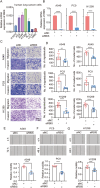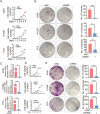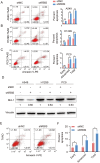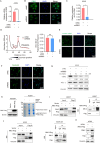RBIS regulates ribosome biogenesis to affect progression in lung adenocarcinoma
- PMID: 39722009
- PMCID: PMC11669223
- DOI: 10.1186/s12967-024-05886-1
RBIS regulates ribosome biogenesis to affect progression in lung adenocarcinoma
Abstract
Background: Increased ribosome biogenesis is required for tumor growth. In this study, we investigated the function and underlying molecular mechanism of ribosome biogenesis factor (RBIS) in the progression of non-small cell lung cancer (NSCLC).
Methods: In our study, we conducted a comprehensive analysis to identify key genes implicated in ribosome biogenesis by leveraging a Gene Set Enrichment Analysis (GSEA) dataset. Subsequently, we performed a comparative analysis of gene expression profiles by utilizing data from the Gene Expression Omnibus (GEO) datasets to ascertain differentially expressed genes (DEGs) between cancerous and adjacent non-cancerous tissues. Through the intersection of gene sets derived from GSEA and GEO, we identified a cohort of ribosome-associated genes that might exert a substantial influence on the progression of lung adenocarcinoma. Following an extensive literature review, we have identified the RBIS gene as an interesting candidate for further investigation. To elucidate the in vitro functional role of RBIS, several assays was employed, including the Transwell migration and invasion assay, wound healing assay, Cell Counting Kit-8 (CCK-8) proliferation assay, and colony formation assay. Subcutaneous and tail vein injection-based lung metastasis xenograft tumor models were used in evaluating the tumorigenic potential, growth, and metastatic spread of lung cancer cells. Flow cytometry analysis was employed to investigate cell cycle distribution and apoptotic rates. Additionally, real-time quantitative reverse transcription polymerase chain reaction (qRT-PCR) was utilized to quantify the mRNA expression levels of genes. To comprehensively assess the translational efficiency of nascent proteins, we employed polysome profiling analysis to provide insights into the cellular translational landscape. Furthermore, we quantified global protein synthesis using a fluorescence-based assay to measure protein synthesis rates. The immunofluorescence technology was utilized to study the subcellular reorganization of the nucleolus. We conducted co-immunoprecipitation (Co-IP) assays followed by Western blot analysis to identify potential proteins interacted with RBIS. The half maximal inhibitory concentration (IC50) was used for evaluating the chemosensitivity of lung cancer cells to gemcitabine. Additionally, the colony formation assay was employed to assess the survival and proliferative capacity post-treatment of gemcitabine.
Results: The database analysis showed that RBIS was upregulated in lung adenocarcinoma, and its high expression was associated with poor prognosis; Knockdown of RBIS significantly inhibited NSCLC cell migration, invasion and proliferation in vitro and xenograft tumor growth and metastasis in vivo. Additionally, knockdown of RBIS led to G0/G1 phase arrest and significantly increased apoptosis in lung adenocarcinoma cells. Mechanistically, downregulation of RBIS significantly decreased the expression of 47S ribosomal RNA (rRNA), a component associated with ribosome assembly. Polysome profiling analysis indicated that RBIS knockdown affected protein translation efficiency, and global protein synthesis assay further verified that RBIS knockdown inhibited synthesis of newborn proteins. Additionally, the ribosomal biogenesis-targeting drugs CX-5461 and the loss of RBIS exhibited synergistic effects in inhibiting cell cycle progression and inducing apoptosis. Furthermore, the ribosomal maturation factor GNL2 was identified as the key downstream regulator of RBIS in ribosome biogenesis. Notably, knockdown of RBIS substantially increased the sensitivity of lung adenocarcinoma cells to the chemotherapeutic drug gemcitabine, highlighting its l role in chemotherapy.
Conclusions: Collectively, these studies suggested the close involvement of RBIS in the progression of lung adenocarcinoma, providing new insights for targeted therapeutic interventions involving ribosomes.
Keywords: Gemcitabine sensitivity; Lung adenocarcinoma; RBIS; Ribosome biogenesis.
© 2024. The Author(s).
Conflict of interest statement
Declarations. Ethics approval and consent to participate: The study was approved by the Ethics Committee of Fudan University Shanghai Cancer Center (Certificate number: 050432-4-2108*). All experiments on mice were conducted through guidelines approved by the Animal Care and Use Committee of Fudan University Shanghai Cancer Center (Certificate number: FUSCC-IACUC-2024284). Consent for publication: All the authors agree on the publication of the results of the present manuscript. Competing interests: The authors declare that they have no competing interests.
Figures








Similar articles
-
Lipocalin-2 promotes NSCLC progression by activating the JAK2/STAT3 signaling pathway.J Transl Med. 2025 Apr 10;23(1):419. doi: 10.1186/s12967-025-06418-1. J Transl Med. 2025. PMID: 40211270 Free PMC article.
-
KIF18B as a regulator in microtubule movement accelerates tumor progression and triggers poor outcome in lung adenocarcinoma.Tissue Cell. 2019 Dec;61:44-50. doi: 10.1016/j.tice.2019.09.001. Epub 2019 Sep 3. Tissue Cell. 2019. PMID: 31759406
-
The role of tRF-Val-CAC-010 in lung adenocarcinoma: implications for tumorigenesis and metastasis.BMC Cancer. 2024 Aug 21;24(1):1033. doi: 10.1186/s12885-024-12800-x. BMC Cancer. 2024. PMID: 39169309 Free PMC article.
-
From Snapshots to Flipbook-Resolving the Dynamics of Ribosome Biogenesis with Chemical Probes.Int J Mol Sci. 2020 Apr 23;21(8):2998. doi: 10.3390/ijms21082998. Int J Mol Sci. 2020. PMID: 32340379 Free PMC article. Review.
-
Crosstalk between c-Myc and ribosome in ribosomal biogenesis and cancer.J Cell Biochem. 2008 Oct 15;105(3):670-7. doi: 10.1002/jcb.21895. J Cell Biochem. 2008. PMID: 18773413 Free PMC article. Review.
References
-
- Sung H, Ferlay J, Siegel RL, Laversanne M, Soerjomataram I, Jemal A, et al. Global cancer statistics 2020: GLOBOCAN estimates of incidence and mortality worldwide for 36 cancers in 185 countries. CA Cancer J Clin. 2021;71:209–49. - PubMed
-
- Relli V, Trerotola M, Guerra E, Alberti S. Abandoning the notion of non-small cell lung cancer. Trends Mol Med. 2019;25:585–94. - PubMed
-
- Yang XM, Wang XQ, Hu LP, Feng MX, Zhou YQ, Li DX, et al. Nucleolar HEAT repeat containing 1 up-regulated by the mechanistic target of rapamycin complex 1 signaling promotes hepatocellular carcinoma growth by dominating ribosome biogenesis and proteome homeostasis. Gastroenterology. 2023;165:629–46. - PubMed
MeSH terms
Substances
Grants and funding
LinkOut - more resources
Full Text Sources
Medical

